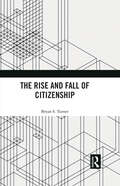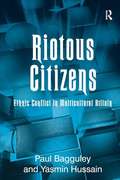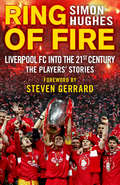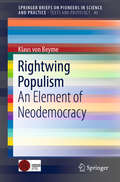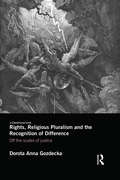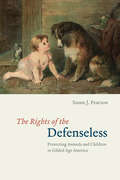- Table View
- List View
The Rise and Fall of Citizenship
by Bryan S. TurnerThe Rise and Fall of Citizenship brings together many of Turner’s publications on the topic of citizenship and includes three new chapters reflecting upon conceptions of citizenship today. The collection begins with a newly written overview of the rise of social citizenship (with particular reference to the UK and the US from 1945 to the 1980s) which charts the experiences of the ‘Baby Boomers’ that benefited from the creation of welfare states, post- war reconstruction, and the commitment to full employment. The core chapters are based on previously published articles, primarily from Taylor & Francis’ Citizenship Studies journal. These chapters examine and critique various sociological and political theories of citizenship and social rights as expounded in the works of R.H. Tawney, J.M. Keynes, T.H. Marshall, Ralf Dahrendorf, Judith Shklar, Peter Townsend, Bernard Crick, and Jüergen Habermas, among others. Later chapters bring the concept of citizenship up to date. Since the 1980s, the UK and the US have been radically altered by neoliberal economic policies involving the deindustrialization of capitalism and an emphasis on financial institutions, which have given rise to new patterns of inequality and changing labour markets. In describing where we are now, Turner argues that new forms of employment instability and uncertainty are captured by the idea of ‘the precariat’ and that citizens now experience their social world as if they were denizens. Turner also considers the impact of demographic changes and increased immigration, widely opposed by populist parties, on conceptions of citizenship. Migration and membership are also examined with reference to issues of dual citizenship, permanent residence, and ‘citizenship for cash’. The final chapter considers the ongoing relevance of the ancient law of hospitality, positing how the migrant can be considered as an asset rather than a threat. This wide-ranging and thought-provoking collection will be of interest to scholars and students in the humanities and social sciences with a focus on citizenship and rights.
The Rise and Fall of Citizenship
by Bryan S. TurnerThe Rise and Fall of Citizenship brings together many of Turner’s publications on the topic of citizenship and includes three new chapters reflecting upon conceptions of citizenship today. The collection begins with a newly written overview of the rise of social citizenship (with particular reference to the UK and the US from 1945 to the 1980s) which charts the experiences of the ‘Baby Boomers’ that benefited from the creation of welfare states, post- war reconstruction, and the commitment to full employment. The core chapters are based on previously published articles, primarily from Taylor & Francis’ Citizenship Studies journal. These chapters examine and critique various sociological and political theories of citizenship and social rights as expounded in the works of R.H. Tawney, J.M. Keynes, T.H. Marshall, Ralf Dahrendorf, Judith Shklar, Peter Townsend, Bernard Crick, and Jüergen Habermas, among others. Later chapters bring the concept of citizenship up to date. Since the 1980s, the UK and the US have been radically altered by neoliberal economic policies involving the deindustrialization of capitalism and an emphasis on financial institutions, which have given rise to new patterns of inequality and changing labour markets. In describing where we are now, Turner argues that new forms of employment instability and uncertainty are captured by the idea of ‘the precariat’ and that citizens now experience their social world as if they were denizens. Turner also considers the impact of demographic changes and increased immigration, widely opposed by populist parties, on conceptions of citizenship. Migration and membership are also examined with reference to issues of dual citizenship, permanent residence, and ‘citizenship for cash’. The final chapter considers the ongoing relevance of the ancient law of hospitality, positing how the migrant can be considered as an asset rather than a threat. This wide-ranging and thought-provoking collection will be of interest to scholars and students in the humanities and social sciences with a focus on citizenship and rights.
The Rise and Fall of an Urban Sexual Community: Malate (Dis)placed
by Dana CollinsThis book examines how gay place-making challenged the juggernaut of neoliberal urbanization in the Malate district of Manila. In this ethnography, Collins explores the creation of place, characterized by neighborhood renewal, gay community and entrepreneurialism, and informal gay sexual labor. Malate teaches us that the power of sexual community to sustain a transgressive, inclusive, gay neighborhood is circumscribed and fleeting, and that urban livability, justice, and freedom must be pursued through organized grassroots political projects if the magic of Malate is to be revived for all its residents.
Riotous Citizens (PDF): Ethnic Conflict In Multicultural Britain
by Paul Bagguley Yasmin HussainIn 2001, Britain saw another summer of rioting in its cities, with violent uprisings in Oldham, Burnley and Bradford. This book explores the reasons for those riots and explains why they mark a new departure in Britain's racial politics. Riots involving racial factors are nothing new in Britain. Historically violent uprisings could be blamed on heavy policing of predominantly minority communities, but the riots of 2001 were more complex. With elements of 1950s-style race riots and echoes of the 1980s riots which saw South Asians confronting the police as the adversary, the spread of unrest in 2001 was also clearly linked to poverty, unemployment and the involvement of the political far-right. Linking original empirical research conducted amongst the Pakistani community in Bradford with a sophisticated conceptual analysis, this book will be required reading for courses on race and ethnicity, social movements and policing public order.
Riotous citizens: Ethnic Conflict in Multicultural Britain
by Paul Bagguley Yasmin HussainIn 2001, Britain saw another summer of rioting in its cities, with violent uprisings in Oldham, Burnley and Bradford. This book explores the reasons for those riots and explains why they mark a new departure in Britain's racial politics. Riots involving racial factors are nothing new in Britain. Historically violent uprisings could be blamed on heavy policing of predominantly minority communities, but the riots of 2001 were more complex. With elements of 1950s-style race riots and echoes of the 1980s riots which saw South Asians confronting the police as the adversary, the spread of unrest in 2001 was also clearly linked to poverty, unemployment and the involvement of the political far-right. Linking original empirical research conducted amongst the Pakistani community in Bradford with a sophisticated conceptual analysis, this book will be required reading for courses on race and ethnicity, social movements and policing public order.
Riot, Unrest and Protest on the Global Stage
by David PritchardIn this collection, leading international scholars examine riots and protest in a range of countries and contexts, exploring the major social transformations of rioting and the changing dynamics, interpretation and potency of unrest in a globalised era.
Rio de Janeiro: Urban Life through the Eyes of the City (CRESC)
by Beatriz Jaguaribe"Through artistic imaginaries, media productions, social practices and spatial mappings, this book offers an insightful and original contribution to the understanding of Rio de Janeiro, one of the highly contested urban terrains in the world. Offering a rich diversity of examples extracted from lived experience, iconographic materials, and narratives, it provides innovative and compelling connections between theoretical questions and urban vignettes. Throughout the essays, the specificity of Rio de Janeiro is highlighted but framed in relation to theoretical questions that are relevant to major contemporary cities. The book underlines the dilemmas of a city that attempts to compete globally while confronting social inequality, violence, and novel forms of democratic agency. It retraces Rio de Janeiro’s modernist memories as the former political/cultural capital of Brazilian intelligentsia and national culture. It explores Rio as a city of popular culture, mestizo legacies, media productions, and cultural innovation."
Rio de Janeiro: Urban Life through the Eyes of the City (CRESC)
by Beatriz Jaguaribe"Through artistic imaginaries, media productions, social practices and spatial mappings, this book offers an insightful and original contribution to the understanding of Rio de Janeiro, one of the highly contested urban terrains in the world. Offering a rich diversity of examples extracted from lived experience, iconographic materials, and narratives, it provides innovative and compelling connections between theoretical questions and urban vignettes. Throughout the essays, the specificity of Rio de Janeiro is highlighted but framed in relation to theoretical questions that are relevant to major contemporary cities. The book underlines the dilemmas of a city that attempts to compete globally while confronting social inequality, violence, and novel forms of democratic agency. It retraces Rio de Janeiro’s modernist memories as the former political/cultural capital of Brazilian intelligentsia and national culture. It explores Rio as a city of popular culture, mestizo legacies, media productions, and cultural innovation."
Ring of Fire: Liverpool into the 21st century: The Players' Stories
by Simon HughesFollowing the success of Simon Hughes’ Red Machine and Men in White Suits, books which depicted Liverpool FC’s domination during the 1980s and its subsequent fall in the 1990s, Ring of Fire focuses on the 2000s and the primary characters who propelled Liverpool to the forefront of European football once again. With a foreword by Steven Gerrard, this is the third edition in a bestselling series based on revealing interviews with former players, coaches and managers. For Liverpool FC, entry into the 21st century began with modernisation and trophies under manager Gérard Houllier and development was then underpinned by improbable Champions League glory under Rafael Benítez. Yet that is only half of the story. The decade ended with the club being on the verge of administration after the shambolic reign of American owners, Tom Hicks and George Gillett.In Ring of Fire, Hughes’ interviewees – including Jamie Carragher, Xabi Alonso and Michael Owen – take you through Melwood’s training ground gates and into the inner sanctum, the Liverpool dressing room. Each person delivers fascinating insights into the minds of the players, coaches and boardroom members as they talk frankly about exhilarating highs and excruciating lows, from winning cups in Cardiff and Istanbul to the political infighting that undermined a succession of managerial reigns.Ring of Fire tells the real stories: those never told before by the key players who lived through it all.
Rightwing Populism: An Element Of Neodemocracy (Springerbriefs On Pioneers In Science And Practice Ser. #40)
by Klaus Von BeymeThis book, written by a prominent German political scientist and specialist for political theory and comparative government, analyses right-wing populism as a topical theme of postmodern party systems in Europe and the United States.
Rights to Public Space: Law, Culture, and Gentrification in the American West
by Sig LangeggerThis book examines the roles that public space plays in gentrification. Considering both cultural norms of public behavior and the municipal regulation of behavior in public, it shows how commonplace acts in everyday public spaces like sidewalks, streets, and parks work to establish neighborhood legitimacy for newcomers while delegitimizing once authentic public practices of long-timers. With evidence drawn from the formerly Latino neighborhood of Highland in Denver, Colorado, this ethnographic study demonstrates how the regulation of public space plays a pivotal role in neighborhood change. First, there is often a profound disharmony between how people from different cultural complexes interpret and sanction behavior in everyday public spaces. Second, because regulations, codes, urban design, and enforcement protocols are deliberately changed, commonplace activities longtime neighborhood residents feel they have a right to do along sidewalks and streets and within their neighborhood parks sometimes unexpectedly misalign with what is actually possible or legal to do in these publicly accessible spaces.
Rights to Public Space: Law, Culture, and Gentrification in the American West
by Sig LangeggerThis book examines the roles that public space plays in gentrification. Considering both cultural norms of public behavior and the municipal regulation of behavior in public, it shows how commonplace acts in everyday public spaces like sidewalks, streets, and parks work to establish neighborhood legitimacy for newcomers while delegitimizing once authentic public practices of long-timers. With evidence drawn from the formerly Latino neighborhood of Highland in Denver, Colorado, this ethnographic study demonstrates how the regulation of public space plays a pivotal role in neighborhood change. First, there is often a profound disharmony between how people from different cultural complexes interpret and sanction behavior in everyday public spaces. Second, because regulations, codes, urban design, and enforcement protocols are deliberately changed, commonplace activities longtime neighborhood residents feel they have a right to do along sidewalks and streets and within their neighborhood parks sometimes unexpectedly misalign with what is actually possible or legal to do in these publicly accessible spaces.
Rights, Religious Pluralism and the Recognition of Difference: Off the Scales of Justice
by Dorota Anna GozdeckaHuman rights and their principles of interpretation are the leading legal paradigms of our time. Freedom of religion occupies a pivotal position in rights discourses, and the principles supporting its interpretation receive increasing attention from courts and legislative bodies. This book critically evaluates religious pluralism as an emerging legal principle arising from attempts to define the boundaries of freedom of religion. It examines religious pluralism as an underlying aspect of different human rights regimes and constitutional traditions. It is, however, the static and liberal shape religious pluralism has assumed that is taken up critically here. In order to address how difference is vulnerable to elimination, rather than recognition, the book takes up a contemporary ethics of alterity. More generally, and through its reconstruction of a more difference-friendly vision of religious pluralism, it tackles the problem of the role of rights in the era of diverse narratives of emancipation.
Rights, Religious Pluralism and the Recognition of Difference: Off the Scales of Justice
by Dorota Anna GozdeckaHuman rights and their principles of interpretation are the leading legal paradigms of our time. Freedom of religion occupies a pivotal position in rights discourses, and the principles supporting its interpretation receive increasing attention from courts and legislative bodies. This book critically evaluates religious pluralism as an emerging legal principle arising from attempts to define the boundaries of freedom of religion. It examines religious pluralism as an underlying aspect of different human rights regimes and constitutional traditions. It is, however, the static and liberal shape religious pluralism has assumed that is taken up critically here. In order to address how difference is vulnerable to elimination, rather than recognition, the book takes up a contemporary ethics of alterity. More generally, and through its reconstruction of a more difference-friendly vision of religious pluralism, it tackles the problem of the role of rights in the era of diverse narratives of emancipation.
Rights on Trial: How Workplace Discrimination Law Perpetuates Inequality
by Ellen Berrey Robert L. Nelson Laura Beth NielsenGerry Handley faced years of blatant race-based harassment before he filed a complaint against his employer: racist jokes, signs reading “KKK” in his work area, and even questions from coworkers as to whether he had sex with his daughter as slaves supposedly did. He had an unusually strong case, with copious documentation and coworkers’ support, and he settled for $50,000, even winning back his job. But victory came at a high cost. Legal fees cut into Mr. Handley’s winnings, and tensions surrounding the lawsuit poisoned the workplace. A year later, he lost his job due to downsizing by his company. Mr. Handley exemplifies the burden plaintiffs bear in contemporary civil rights litigation. In the decades since the civil rights movement, we’ve made progress, but not nearly as much as it might seem. On the surface, America’s commitment to equal opportunity in the workplace has never been clearer. Virtually every company has antidiscrimination policies in place, and there are laws designed to protect these rights across a range of marginalized groups. But, as Ellen Berrey, Robert L. Nelson, and Laura Beth Nielsen compellingly show, this progressive vision of the law falls far short in practice. When aggrieved individuals turn to the law, the adversarial character of litigation imposes considerable personal and financial costs that make plaintiffs feel like they’ve lost regardless of the outcome of the case. Employer defendants also are dissatisfied with the system, often feeling “held up” by what they see as frivolous cases. And even when the case is resolved in the plaintiff’s favor, the conditions that gave rise to the lawsuit rarely change. In fact, the contemporary approach to workplace discrimination law perversely comes to reinforce the very hierarchies that antidiscrimination laws were created to redress. Based on rich interviews with plaintiffs, attorneys, and representatives of defendants and an original national dataset on case outcomes, Rights on Trial reveals the fundamental flaws of workplace discrimination law and offers practical recommendations for how we might better respond to persistent patterns of discrimination.
Rights on Trial: How Workplace Discrimination Law Perpetuates Inequality
by Ellen Berrey Robert L. Nelson Laura Beth NielsenGerry Handley faced years of blatant race-based harassment before he filed a complaint against his employer: racist jokes, signs reading “KKK” in his work area, and even questions from coworkers as to whether he had sex with his daughter as slaves supposedly did. He had an unusually strong case, with copious documentation and coworkers’ support, and he settled for $50,000, even winning back his job. But victory came at a high cost. Legal fees cut into Mr. Handley’s winnings, and tensions surrounding the lawsuit poisoned the workplace. A year later, he lost his job due to downsizing by his company. Mr. Handley exemplifies the burden plaintiffs bear in contemporary civil rights litigation. In the decades since the civil rights movement, we’ve made progress, but not nearly as much as it might seem. On the surface, America’s commitment to equal opportunity in the workplace has never been clearer. Virtually every company has antidiscrimination policies in place, and there are laws designed to protect these rights across a range of marginalized groups. But, as Ellen Berrey, Robert L. Nelson, and Laura Beth Nielsen compellingly show, this progressive vision of the law falls far short in practice. When aggrieved individuals turn to the law, the adversarial character of litigation imposes considerable personal and financial costs that make plaintiffs feel like they’ve lost regardless of the outcome of the case. Employer defendants also are dissatisfied with the system, often feeling “held up” by what they see as frivolous cases. And even when the case is resolved in the plaintiff’s favor, the conditions that gave rise to the lawsuit rarely change. In fact, the contemporary approach to workplace discrimination law perversely comes to reinforce the very hierarchies that antidiscrimination laws were created to redress. Based on rich interviews with plaintiffs, attorneys, and representatives of defendants and an original national dataset on case outcomes, Rights on Trial reveals the fundamental flaws of workplace discrimination law and offers practical recommendations for how we might better respond to persistent patterns of discrimination.
Rights on Trial: How Workplace Discrimination Law Perpetuates Inequality
by Ellen Berrey Robert L. Nelson Laura Beth NielsenGerry Handley faced years of blatant race-based harassment before he filed a complaint against his employer: racist jokes, signs reading “KKK” in his work area, and even questions from coworkers as to whether he had sex with his daughter as slaves supposedly did. He had an unusually strong case, with copious documentation and coworkers’ support, and he settled for $50,000, even winning back his job. But victory came at a high cost. Legal fees cut into Mr. Handley’s winnings, and tensions surrounding the lawsuit poisoned the workplace. A year later, he lost his job due to downsizing by his company. Mr. Handley exemplifies the burden plaintiffs bear in contemporary civil rights litigation. In the decades since the civil rights movement, we’ve made progress, but not nearly as much as it might seem. On the surface, America’s commitment to equal opportunity in the workplace has never been clearer. Virtually every company has antidiscrimination policies in place, and there are laws designed to protect these rights across a range of marginalized groups. But, as Ellen Berrey, Robert L. Nelson, and Laura Beth Nielsen compellingly show, this progressive vision of the law falls far short in practice. When aggrieved individuals turn to the law, the adversarial character of litigation imposes considerable personal and financial costs that make plaintiffs feel like they’ve lost regardless of the outcome of the case. Employer defendants also are dissatisfied with the system, often feeling “held up” by what they see as frivolous cases. And even when the case is resolved in the plaintiff’s favor, the conditions that gave rise to the lawsuit rarely change. In fact, the contemporary approach to workplace discrimination law perversely comes to reinforce the very hierarchies that antidiscrimination laws were created to redress. Based on rich interviews with plaintiffs, attorneys, and representatives of defendants and an original national dataset on case outcomes, Rights on Trial reveals the fundamental flaws of workplace discrimination law and offers practical recommendations for how we might better respond to persistent patterns of discrimination.
Rights on Trial: How Workplace Discrimination Law Perpetuates Inequality
by Ellen Berrey Robert L. Nelson Laura Beth NielsenGerry Handley faced years of blatant race-based harassment before he filed a complaint against his employer: racist jokes, signs reading “KKK” in his work area, and even questions from coworkers as to whether he had sex with his daughter as slaves supposedly did. He had an unusually strong case, with copious documentation and coworkers’ support, and he settled for $50,000, even winning back his job. But victory came at a high cost. Legal fees cut into Mr. Handley’s winnings, and tensions surrounding the lawsuit poisoned the workplace. A year later, he lost his job due to downsizing by his company. Mr. Handley exemplifies the burden plaintiffs bear in contemporary civil rights litigation. In the decades since the civil rights movement, we’ve made progress, but not nearly as much as it might seem. On the surface, America’s commitment to equal opportunity in the workplace has never been clearer. Virtually every company has antidiscrimination policies in place, and there are laws designed to protect these rights across a range of marginalized groups. But, as Ellen Berrey, Robert L. Nelson, and Laura Beth Nielsen compellingly show, this progressive vision of the law falls far short in practice. When aggrieved individuals turn to the law, the adversarial character of litigation imposes considerable personal and financial costs that make plaintiffs feel like they’ve lost regardless of the outcome of the case. Employer defendants also are dissatisfied with the system, often feeling “held up” by what they see as frivolous cases. And even when the case is resolved in the plaintiff’s favor, the conditions that gave rise to the lawsuit rarely change. In fact, the contemporary approach to workplace discrimination law perversely comes to reinforce the very hierarchies that antidiscrimination laws were created to redress. Based on rich interviews with plaintiffs, attorneys, and representatives of defendants and an original national dataset on case outcomes, Rights on Trial reveals the fundamental flaws of workplace discrimination law and offers practical recommendations for how we might better respond to persistent patterns of discrimination.
Rights on Trial: How Workplace Discrimination Law Perpetuates Inequality
by Ellen Berrey Robert L. Nelson Laura Beth NielsenGerry Handley faced years of blatant race-based harassment before he filed a complaint against his employer: racist jokes, signs reading “KKK” in his work area, and even questions from coworkers as to whether he had sex with his daughter as slaves supposedly did. He had an unusually strong case, with copious documentation and coworkers’ support, and he settled for $50,000, even winning back his job. But victory came at a high cost. Legal fees cut into Mr. Handley’s winnings, and tensions surrounding the lawsuit poisoned the workplace. A year later, he lost his job due to downsizing by his company. Mr. Handley exemplifies the burden plaintiffs bear in contemporary civil rights litigation. In the decades since the civil rights movement, we’ve made progress, but not nearly as much as it might seem. On the surface, America’s commitment to equal opportunity in the workplace has never been clearer. Virtually every company has antidiscrimination policies in place, and there are laws designed to protect these rights across a range of marginalized groups. But, as Ellen Berrey, Robert L. Nelson, and Laura Beth Nielsen compellingly show, this progressive vision of the law falls far short in practice. When aggrieved individuals turn to the law, the adversarial character of litigation imposes considerable personal and financial costs that make plaintiffs feel like they’ve lost regardless of the outcome of the case. Employer defendants also are dissatisfied with the system, often feeling “held up” by what they see as frivolous cases. And even when the case is resolved in the plaintiff’s favor, the conditions that gave rise to the lawsuit rarely change. In fact, the contemporary approach to workplace discrimination law perversely comes to reinforce the very hierarchies that antidiscrimination laws were created to redress. Based on rich interviews with plaintiffs, attorneys, and representatives of defendants and an original national dataset on case outcomes, Rights on Trial reveals the fundamental flaws of workplace discrimination law and offers practical recommendations for how we might better respond to persistent patterns of discrimination.
Rights on Trial: How Workplace Discrimination Law Perpetuates Inequality
by Ellen Berrey Robert L. Nelson Laura Beth NielsenGerry Handley faced years of blatant race-based harassment before he filed a complaint against his employer: racist jokes, signs reading “KKK” in his work area, and even questions from coworkers as to whether he had sex with his daughter as slaves supposedly did. He had an unusually strong case, with copious documentation and coworkers’ support, and he settled for $50,000, even winning back his job. But victory came at a high cost. Legal fees cut into Mr. Handley’s winnings, and tensions surrounding the lawsuit poisoned the workplace. A year later, he lost his job due to downsizing by his company. Mr. Handley exemplifies the burden plaintiffs bear in contemporary civil rights litigation. In the decades since the civil rights movement, we’ve made progress, but not nearly as much as it might seem. On the surface, America’s commitment to equal opportunity in the workplace has never been clearer. Virtually every company has antidiscrimination policies in place, and there are laws designed to protect these rights across a range of marginalized groups. But, as Ellen Berrey, Robert L. Nelson, and Laura Beth Nielsen compellingly show, this progressive vision of the law falls far short in practice. When aggrieved individuals turn to the law, the adversarial character of litigation imposes considerable personal and financial costs that make plaintiffs feel like they’ve lost regardless of the outcome of the case. Employer defendants also are dissatisfied with the system, often feeling “held up” by what they see as frivolous cases. And even when the case is resolved in the plaintiff’s favor, the conditions that gave rise to the lawsuit rarely change. In fact, the contemporary approach to workplace discrimination law perversely comes to reinforce the very hierarchies that antidiscrimination laws were created to redress. Based on rich interviews with plaintiffs, attorneys, and representatives of defendants and an original national dataset on case outcomes, Rights on Trial reveals the fundamental flaws of workplace discrimination law and offers practical recommendations for how we might better respond to persistent patterns of discrimination.
The Rights of Women in Islam: An Authentic Approach
by H. JawadIt has been argued that Islam liberated Muslim women by granting them full rights as citizens. Yet in reality we see that women have long been subjected to both cultural and political oppression. Instances such as forced marriages are sadly common in the Muslim World, as are restrictions on education and on their role in the labour force.
The Rights of the Defenseless: Protecting Animals and Children in Gilded Age America
by Susan J. PearsonIn 1877, the American Humane Society was formed as the national organization for animal and child protection. Thirty years later, there were 354 anticruelty organizations chartered in the United States, nearly 200 of which were similarly invested in the welfare of both humans and animals. In The Rights of the Defenseless, Susan J. Pearson seeks to understand the institutional, cultural, legal, and political significance of the perceived bond between these two kinds of helpless creatures, and the attempts made to protect them. Unlike many of today’s humane organizations, those Pearson follows were delegated police powers to make arrests and bring cases of cruelty to animals and children before local magistrates. Those whom they prosecuted were subject to fines, jail time, and the removal of either animal or child from their possession. Pearson explores the limits of and motivation behind this power and argues that while these reformers claimed nothing more than sympathy with the helpless and a desire to protect their rights, they turned “cruelty” into a social problem, stretched government resources, and expanded the state through private associations. The first book to explore these dual organizations and their storied history, The Rights of the Defenseless will appeal broadly to reform-minded historians and social theorists alike.
The Rights of the Defenseless: Protecting Animals and Children in Gilded Age America
by Susan J. PearsonIn 1877, the American Humane Society was formed as the national organization for animal and child protection. Thirty years later, there were 354 anticruelty organizations chartered in the United States, nearly 200 of which were similarly invested in the welfare of both humans and animals. In The Rights of the Defenseless, Susan J. Pearson seeks to understand the institutional, cultural, legal, and political significance of the perceived bond between these two kinds of helpless creatures, and the attempts made to protect them. Unlike many of today’s humane organizations, those Pearson follows were delegated police powers to make arrests and bring cases of cruelty to animals and children before local magistrates. Those whom they prosecuted were subject to fines, jail time, and the removal of either animal or child from their possession. Pearson explores the limits of and motivation behind this power and argues that while these reformers claimed nothing more than sympathy with the helpless and a desire to protect their rights, they turned “cruelty” into a social problem, stretched government resources, and expanded the state through private associations. The first book to explore these dual organizations and their storied history, The Rights of the Defenseless will appeal broadly to reform-minded historians and social theorists alike.
The Rights of the Defenseless: Protecting Animals and Children in Gilded Age America
by Susan J. PearsonIn 1877, the American Humane Society was formed as the national organization for animal and child protection. Thirty years later, there were 354 anticruelty organizations chartered in the United States, nearly 200 of which were similarly invested in the welfare of both humans and animals. In The Rights of the Defenseless, Susan J. Pearson seeks to understand the institutional, cultural, legal, and political significance of the perceived bond between these two kinds of helpless creatures, and the attempts made to protect them. Unlike many of today’s humane organizations, those Pearson follows were delegated police powers to make arrests and bring cases of cruelty to animals and children before local magistrates. Those whom they prosecuted were subject to fines, jail time, and the removal of either animal or child from their possession. Pearson explores the limits of and motivation behind this power and argues that while these reformers claimed nothing more than sympathy with the helpless and a desire to protect their rights, they turned “cruelty” into a social problem, stretched government resources, and expanded the state through private associations. The first book to explore these dual organizations and their storied history, The Rights of the Defenseless will appeal broadly to reform-minded historians and social theorists alike.
The Rights of the Defenseless: Protecting Animals and Children in Gilded Age America
by Susan J. PearsonIn 1877, the American Humane Society was formed as the national organization for animal and child protection. Thirty years later, there were 354 anticruelty organizations chartered in the United States, nearly 200 of which were similarly invested in the welfare of both humans and animals. In The Rights of the Defenseless, Susan J. Pearson seeks to understand the institutional, cultural, legal, and political significance of the perceived bond between these two kinds of helpless creatures, and the attempts made to protect them. Unlike many of today’s humane organizations, those Pearson follows were delegated police powers to make arrests and bring cases of cruelty to animals and children before local magistrates. Those whom they prosecuted were subject to fines, jail time, and the removal of either animal or child from their possession. Pearson explores the limits of and motivation behind this power and argues that while these reformers claimed nothing more than sympathy with the helpless and a desire to protect their rights, they turned “cruelty” into a social problem, stretched government resources, and expanded the state through private associations. The first book to explore these dual organizations and their storied history, The Rights of the Defenseless will appeal broadly to reform-minded historians and social theorists alike.
